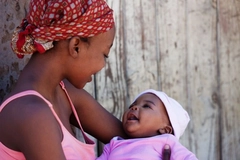WHO highlights nutrition’s role in SDGs and urges businesses to act
The WHO’s “Together for Nutrition” initiative is forging connections between improved nutrition and the UN Sustainable Development Goals (SDGs).
Laurence M. Grummer-Strawn, WHO’s unit head for Food and Nutrition Action in Health Systems in the Department of Nutrition and Food Safety, tells Nutrition Insight about the initiative’s role in tackling malnutrition, driving bold policies and fostering multi-sectoral commitments to advance goals like Zero Hunger, Good Health and Well-Being and Climate Action.
He believes that proven solutions exist, but scaling them remains critical to ensuring vulnerable populations and low-income countries reap the benefits.
Grummer-Strawn claims that SDG 2.2 is centered on eradicating malnutrition, so the Together for Nutrition campaign is most closely related to SDG 2 on Zero Hunger. The campaign was recently celebrated at the 79th UN General Assembly when the WHO joined the Nutrition for Growth coalition.
“Nutrition is also critical for SDG 3, as poor nutrition contributes to child mortality, susceptibility to infectious disease and the development of non-communicable diseases such as obesity, diabetes and cardiovascular disease. Nutrition in early life is critical for brain development and is thus a long-term contributor to progress on SDG 4 for education,” he adds.

“Many nutrition priorities, such as increased breastfeeding, avoidance of ultra-processed foods and reductions in red meat consumption, are also priorities for reducing the food industry’s carbon footprint and thus contribute to the achievement of SDGs 12 and 13 on responsible consumption/production and climate action.”
Grummer-Strawn states that the most important commitment from private sector entities will be to “address the access, affordability and healthfulness of their products.” He calls for companies “to shift their product portfolios away from ultra-processed foods.”
“They need to find agricultural solutions to make healthy foods easily accessible to low-income families. They need to stop the promotion of breastmilk substitutes and foods high in salt and sugar.”
 Grummer-Strawn urges agricultural solutions to make healthy foods easily accessible to low-income families.Solutions to main challenges
Grummer-Strawn urges agricultural solutions to make healthy foods easily accessible to low-income families.Solutions to main challenges
Speaking about the main challenges in meeting the SDGs, Grummer-Strawn believes that nutrition issues have proven solutions but have not been implemented on a large scale.
“The policies and programs needed to make a major difference continue to have low coverage and are not implemented as intended. A key goal of the initiative is to drive country commitments on investing more in nutrition and enacting bold policies,” he says.
“The Nutrition for Growth Summit will be an opportunity for governments, donors, civil society organizations, the UN and the private sector to announce commitments on what they will do to address key gaps in delivering better nutrition. WHO advocates for strong commitments, developing technical documents on what is needed and providing direct support to countries as they make their decisions.”
Nutrition SDG link
Explaining how nutrition relates to the SDGs, Grummer-Strawn points to breastfeeding as an example of how “optimal nutrition in early life could advance several SDGs.”
“UNICEF has prepared a brief highlighting several linkages between breastfeeding and the SDGs. In addition, the Global Nutrition Report published a list of 53 SDG indicators related to nutrition.”
 Grummer-Strawn says businesses need to stop the promotion of breastmilk substitutes and foods high in salt and sugar.Grummer-Strawn explains that the WHO ensures vulnerable populations, especially in low-income countries, benefit from the Together for Nutrition initiative since the main focus has been on malnutrition issues, “such as acute malnutrition, stunting, low birthweight or anemia that are particularly prevalent in low-income countries.”
Grummer-Strawn says businesses need to stop the promotion of breastmilk substitutes and foods high in salt and sugar.Grummer-Strawn explains that the WHO ensures vulnerable populations, especially in low-income countries, benefit from the Together for Nutrition initiative since the main focus has been on malnutrition issues, “such as acute malnutrition, stunting, low birthweight or anemia that are particularly prevalent in low-income countries.”
“Progressing on the overall magnitude of these problems will require concentrated efforts on the poorest and underserved populations.”
Global efforts
In other developments, we spoke to the UN Food and Agriculture Organization about its “Nourish and Thrive: Inclusive and Sustainable Nutrition and Livelihoods Initiative” in Zimbabwe’s Masvingo and Mwenezi districts. This initiative aims to tackle the challenges of food insecurity and malnutrition exacerbated by drought and El Niño effects.
We also looked at global initiatives ahead of the 2025 Nutrition for Growth Summit, focusing on children, women and climate-impacted communities.















